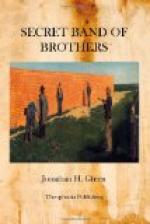I ask the papers of the day to publish this statement in justice to both parties, as well as the public at large.
J. H. GREEN.
No. 8.
Correspondence of the New
York Tribune.
Perrysburgh, Ohio, August 16, 1845.
Mr. Greeley,—I wish to introduce to the columns of your valuable paper the following. Though it may seem mysterious and out of date, it will be read with much interest by many, and may have a tendency to cast a light upon one of the most horrible murders ever committed in this or any other Christian land. There is not one shade of doubt remaining in my mind but that the murderers, as well as their victim or victims, long before the date of this article, might have been discovered, had there been sufficient effort made. True, efforts have at last been made, and the skeleton of one murdered victim found, and much search made for the other. The particulars which led to the but small effort which has already been made, are collected from circumstances as follows:—As near as we can learn, in September, 1844, a gentleman, by the name of Stephens, from the state of New York, made his appearance in Perrysburgh, remained in and near some days, left, sometime after returned. About the time of his departure from the second visit, he made known his business, that he had kept secret until the time near his departure. He then told that two men had been murdered, and their bodies concealed in the woods about one-half mile from the last turnpike gate, which is about four miles from Perrysburgh. His statements corroborating some previous signs of murder, induced the citizens to turn out and scout the swamp in search, knowing as they did that certain packages of clothes had been found in the Maumee river by a fisherman, on the 17th April, 1844. The clothes found were done up in parcels, coat, pantaloons, and vest, with a stone tied round each, with strips of handkerchiefs cut or torn for the purpose. Upon examination, the clothes were cut in a way to show they had been ripped off from the body. The pantaloon’s legs cut open; the coat cut open from the back and sleeves; the vest also cut open from the back. The coat had many cuts in the left sleeve, also a hole about the lower button on the right side, which hole was in the pantaloons, cutting the lower suspender in two. The vest had several cuts in it, immediately back of the neck, through the collar, and two knife holes. The vest is a figured worsted piece of goods, of lilac colour, about half-worn. The coat is a black cloth frock, or surtout, but little worn, no velvet upon it, lined inside of the skirts with black silk or serge, the sleeve lining twilled linen. Inside of the left sleeve is a mark of the merchant, which is one cipher—nothing more. From the looks, I should have taken the coat to have cost twenty dollars. The pantaloons are rather of a blue colour, striped casinet, and have never been worn much. The suspender, which




